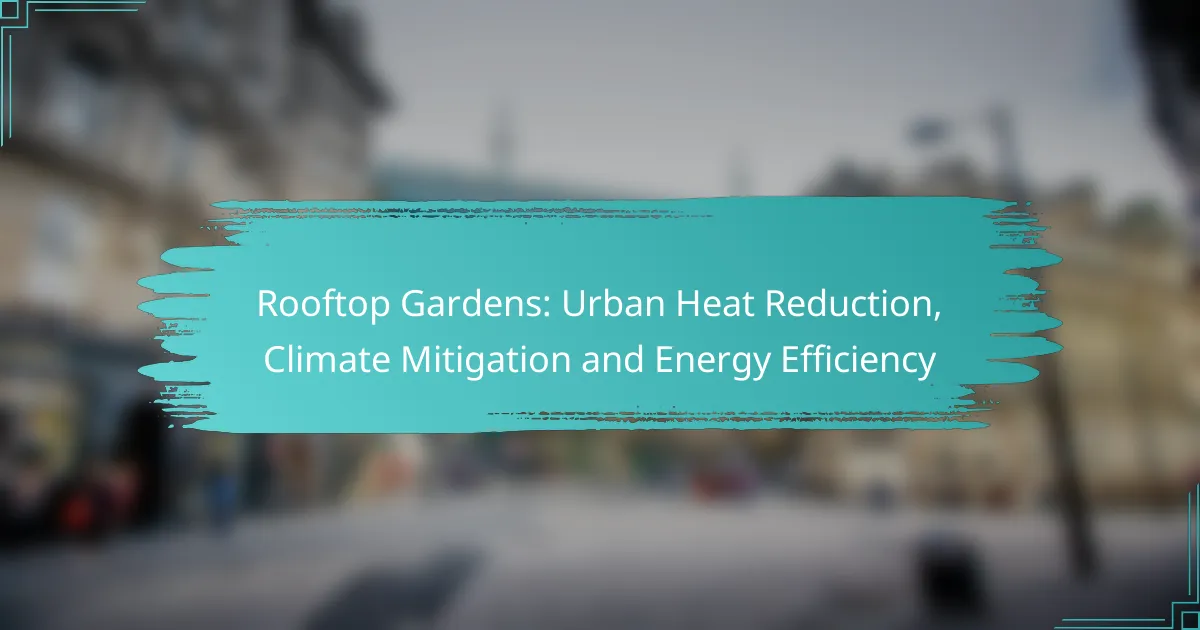Rooftop gardens serve as a vital solution for urban heat reduction, offering natural insulation and cooling effects that enhance the comfort of city environments. By absorbing sunlight and managing stormwater, these green spaces contribute significantly to climate mitigation and improve air quality. Additionally, they enhance energy efficiency in buildings, reducing the reliance on heating and cooling systems and ultimately lowering energy costs.
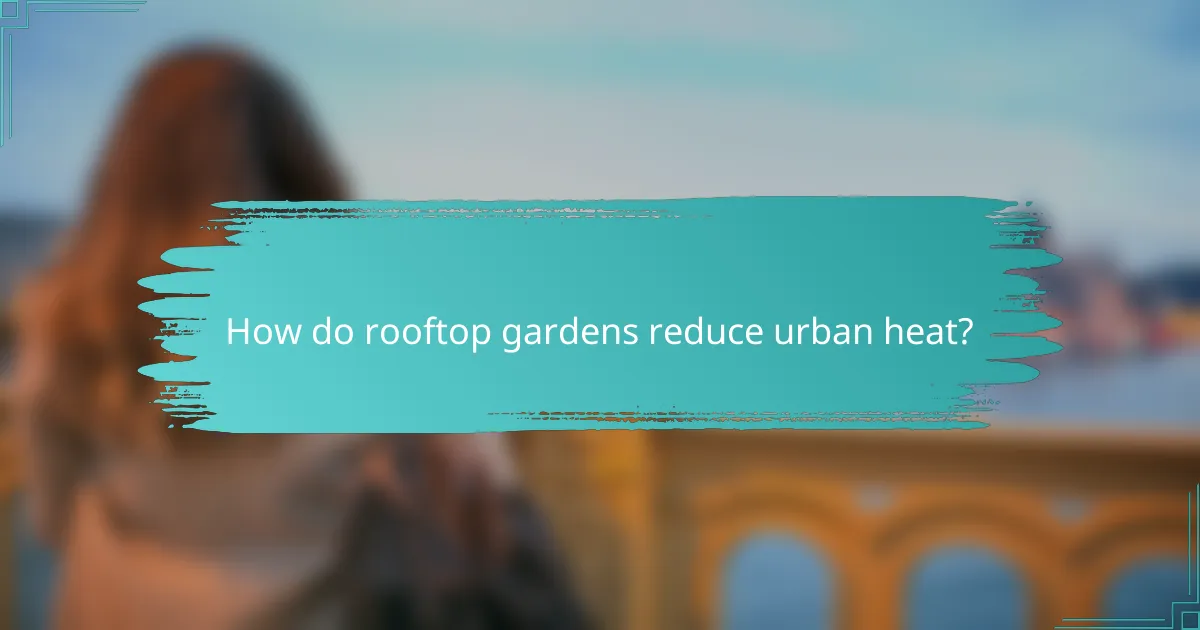
How do rooftop gardens reduce urban heat?
Rooftop gardens effectively lower urban heat by providing natural insulation and cooling effects. They absorb sunlight, reduce heat absorption by buildings, and contribute to a more comfortable urban environment.
Lower ambient temperatures
Rooftop gardens can significantly lower the ambient temperatures in urban areas. By replacing traditional roofs with vegetation, they can reduce surface temperatures by up to 20 degrees Fahrenheit (about 11 degrees Celsius) compared to conventional roofs. This cooling effect helps mitigate the urban heat island phenomenon, where cities experience higher temperatures than surrounding rural areas.
Implementing rooftop gardens can lead to lower energy consumption for cooling, which is particularly beneficial during hot summer months. This reduction in energy use can translate to cost savings on electricity bills, making it an economically viable solution for building owners.
Increase in shade
Rooftop gardens provide shade to the building and surrounding areas, which helps to lower temperatures. The vegetation acts as a natural barrier against direct sunlight, reducing the heat that buildings absorb. This shading effect can decrease the need for air conditioning, leading to further energy savings.
Additionally, shaded areas around buildings can improve outdoor comfort for pedestrians and residents, encouraging more outdoor activities and enhancing the overall quality of urban life.
Evapotranspiration effects
Evapotranspiration is the process by which plants release moisture into the air, contributing to cooling. Rooftop gardens enhance this effect, as the plants absorb water and then release it back into the atmosphere, which cools the surrounding air. This natural cooling mechanism can lower temperatures in urban settings significantly.
Incorporating a variety of plants can maximize evapotranspiration, as different species have varying water needs and growth patterns. Selecting drought-resistant plants can also ensure that the garden remains sustainable while still providing cooling benefits.
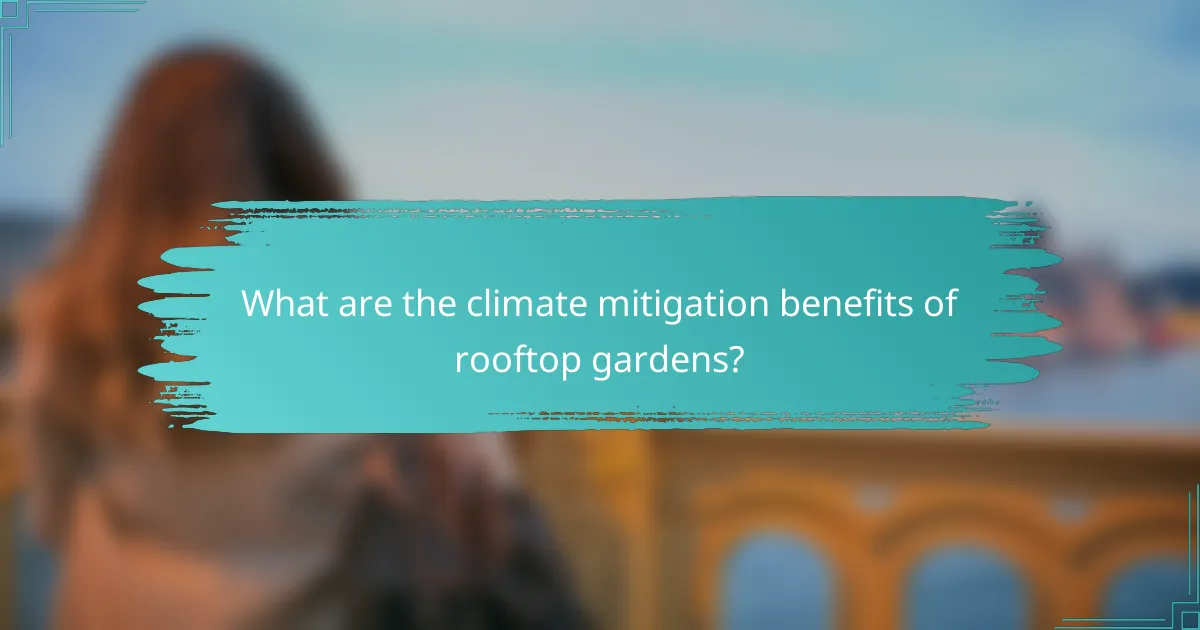
What are the climate mitigation benefits of rooftop gardens?
Rooftop gardens offer significant climate mitigation benefits by reducing urban heat, managing stormwater, and improving air quality. These green spaces help combat climate change while enhancing energy efficiency in buildings.
Carbon dioxide absorption
Rooftop gardens play a crucial role in carbon dioxide absorption, capturing CO2 from the atmosphere and converting it into oxygen through photosynthesis. This process helps lower greenhouse gas levels, contributing to climate mitigation efforts.
Plants in rooftop gardens can absorb varying amounts of CO2 depending on their type and density. For effective carbon sequestration, consider using a mix of native and drought-resistant species that thrive in your local climate.
Stormwater management
Rooftop gardens significantly aid in stormwater management by absorbing rainwater, which reduces runoff and minimizes the risk of flooding in urban areas. This absorption helps filter pollutants before they enter the drainage system.
Implementing a rooftop garden can reduce stormwater runoff by up to 50% or more, depending on the garden’s design and plant selection. Incorporating features like retention basins or permeable surfaces can enhance this benefit.
Improved air quality
Rooftop gardens contribute to improved air quality by filtering pollutants and particulate matter from the air. The vegetation captures dust, smoke, and other harmful particles, leading to healthier urban environments.
In addition to capturing pollutants, rooftop gardens can lower urban temperatures, which helps reduce the formation of ground-level ozone. This can be particularly beneficial in densely populated cities where air quality issues are prevalent.
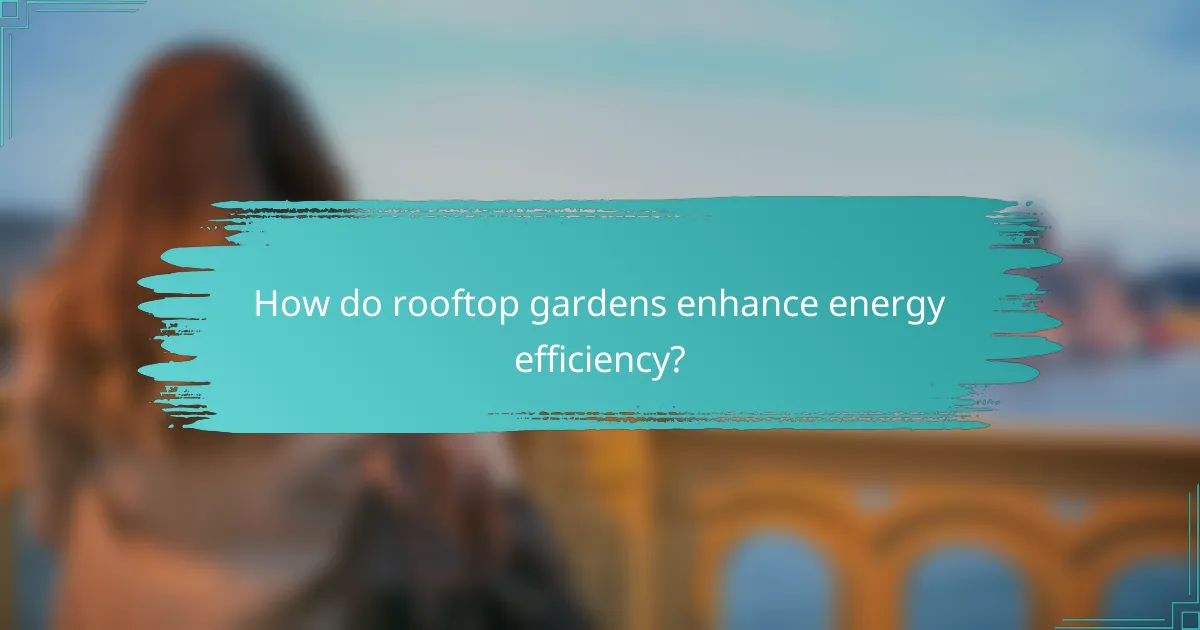
How do rooftop gardens enhance energy efficiency?
Rooftop gardens enhance energy efficiency by reducing the need for heating and cooling in buildings. They provide natural insulation and help mitigate the urban heat island effect, leading to lower energy consumption and costs.
Reduction in energy consumption
Rooftop gardens can significantly lower energy consumption by decreasing the temperature of buildings during hot months. By absorbing sunlight and providing shade, these gardens reduce the reliance on air conditioning systems, which can account for a large portion of energy use in urban areas.
Studies suggest that buildings with rooftop gardens can experience energy savings of around 20-30% during peak summer months. This reduction not only benefits the environment but also lowers utility bills for homeowners and businesses.
Improved insulation
Rooftop gardens improve insulation by adding an extra layer between the roof and the interior of the building. This layer helps maintain a stable indoor temperature, reducing the need for heating in winter and cooling in summer.
Plants and soil act as natural insulators, which can lead to a temperature reduction of several degrees inside the building. This effect is particularly beneficial in regions with extreme temperature fluctuations, enhancing overall energy efficiency.
Lower HVAC costs
By improving insulation and reducing energy consumption, rooftop gardens can lead to lower heating, ventilation, and air conditioning (HVAC) costs. The initial investment in a rooftop garden can be offset by the long-term savings on energy bills.
Property owners can expect to see a decrease in HVAC maintenance costs as well, as systems are less stressed when operating in a more stable temperature environment. This can extend the lifespan of HVAC equipment, further contributing to cost savings.
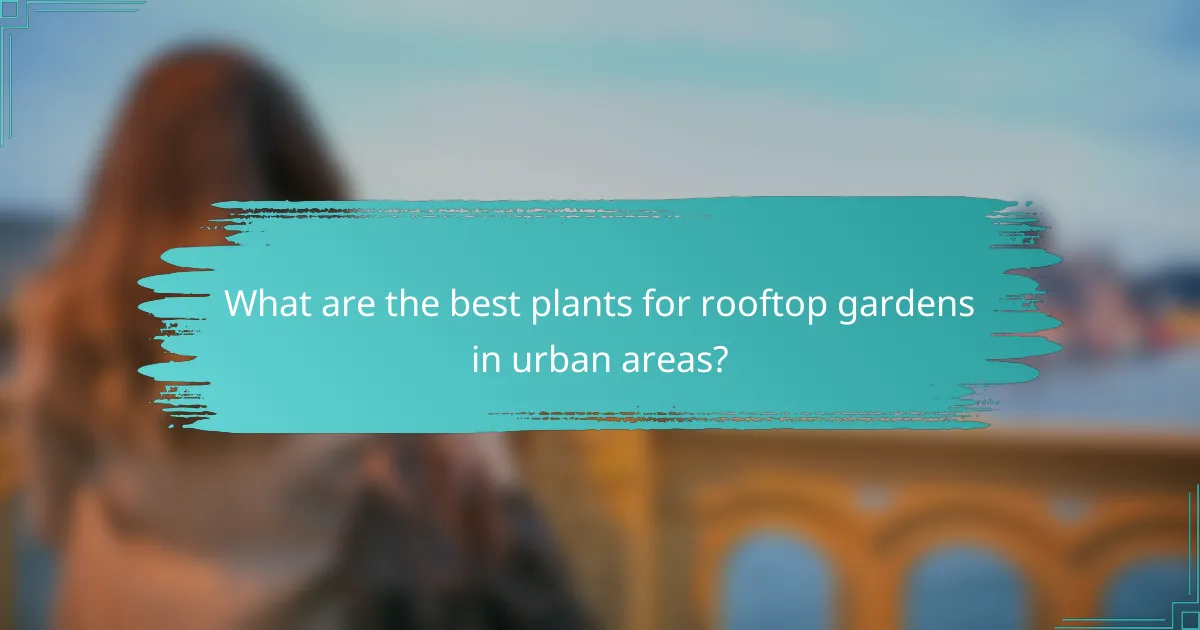
What are the best plants for rooftop gardens in urban areas?
The best plants for rooftop gardens in urban areas are those that thrive in limited soil and water conditions while providing aesthetic and environmental benefits. Consideration of local climate and the specific rooftop environment is crucial for selecting the most suitable species.
Succulents and drought-resistant plants
Succulents and drought-resistant plants are ideal for rooftop gardens due to their ability to store water and survive in arid conditions. Varieties such as sedum, agave, and aloe vera require minimal maintenance and can withstand high temperatures, making them perfect for urban settings.
When choosing succulents, ensure they receive adequate sunlight and are planted in well-draining soil. Grouping these plants together can create a visually appealing arrangement while maximizing water efficiency.
Native plant species
Native plant species are well-adapted to local climates and soil conditions, making them a sustainable choice for urban rooftop gardens. These plants typically require less water and maintenance compared to non-native varieties, promoting biodiversity and supporting local ecosystems.
Research local flora to identify native species that thrive in your area. Incorporating plants like coneflowers, black-eyed Susans, or local grasses can enhance the garden’s resilience and reduce the need for chemical fertilizers and pesticides.
Vegetable and herb options
Vegetables and herbs can be successfully grown in rooftop gardens, providing fresh produce and enhancing culinary experiences. Consider compact varieties such as cherry tomatoes, peppers, basil, and mint, which can thrive in containers and limited space.
When planning a vegetable garden, ensure access to sunlight for at least six hours a day and use high-quality potting soil. Regular watering and fertilization will support healthy growth, and rotating crops can help maintain soil nutrients. Aim for a mix of plants to maximize yield and diversity.

How to design an effective rooftop garden?
Designing an effective rooftop garden involves careful planning and consideration of various factors to ensure its success. Key elements include site assessment, soil and drainage management, and appropriate plant selection to maximize benefits such as heat reduction and energy efficiency.
Site assessment and planning
Begin by evaluating the structural integrity of the rooftop to support the garden’s weight, including soil, plants, and water. Check local regulations regarding rooftop gardens, as some areas may have specific guidelines or restrictions.
Consider the sun exposure and wind patterns of the site. South-facing roofs typically receive more sunlight, making them ideal for sun-loving plants. Additionally, assess access for maintenance and irrigation, ensuring that the design allows for easy care.
Soil and drainage considerations
Proper soil selection is crucial for a thriving rooftop garden. Use lightweight soil mixes designed for rooftop applications, which typically include components like expanded clay, perlite, and organic matter to retain moisture without adding excessive weight.
Implement a reliable drainage system to prevent water accumulation, which can damage the building structure. A drainage layer, such as gravel or perforated drainage mats, can help facilitate proper water flow while maintaining soil moisture levels.
Plant selection and layout
Choose plants that are well-suited for rooftop environments, considering factors like drought tolerance and wind resistance. Native plants are often a good choice, as they are adapted to local conditions and require less maintenance.
Plan the layout to maximize sunlight exposure and create visual interest. Group plants with similar water and light needs together to simplify care. Consider incorporating a mix of perennials, annuals, and even edible plants to enhance biodiversity and utility.
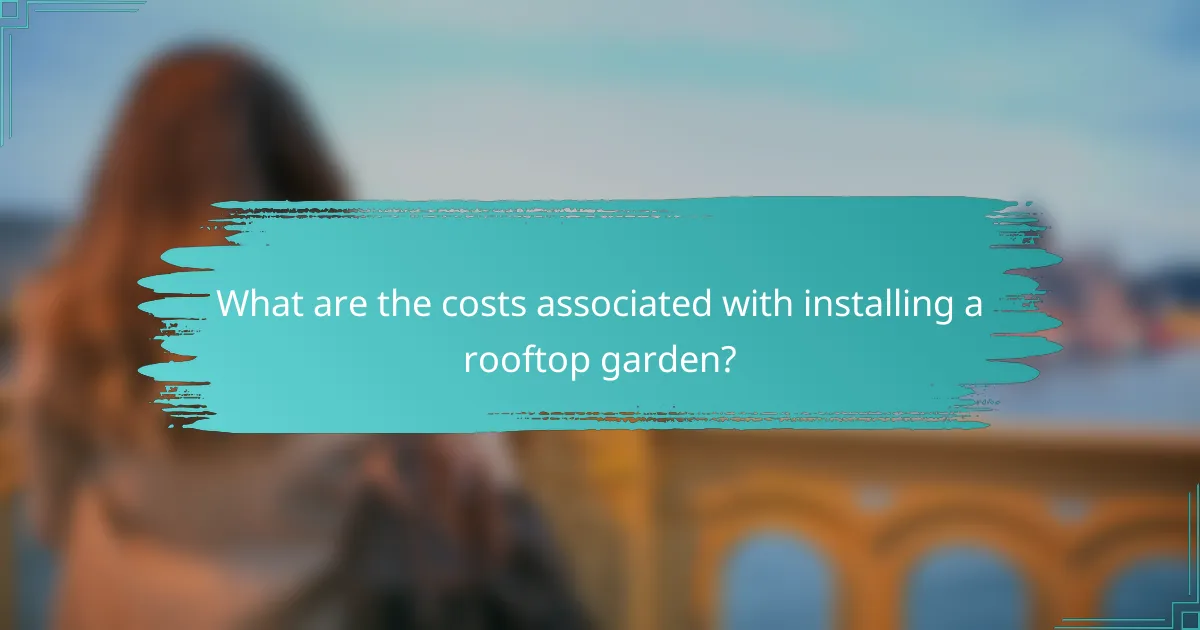
What are the costs associated with installing a rooftop garden?
The costs of installing a rooftop garden can vary significantly based on factors such as size, design, and materials used. Generally, the total investment includes initial setup costs, ongoing maintenance, and potential savings on energy bills.
Initial setup costs
Initial setup costs for a rooftop garden typically range from several thousand to tens of thousands of dollars. Key expenses include structural assessments, waterproofing, soil, plants, and irrigation systems. For a small to medium-sized garden, expect to budget around $15 to $30 per square foot.
When planning your rooftop garden, consider hiring professionals for design and installation to ensure proper drainage and plant selection. This can add to the upfront costs but may save you money in the long run by preventing structural damage or plant failure.
Additionally, local regulations may influence costs. Some cities offer incentives or grants for green roofs, which can help offset the initial investment. Research available programs in your area to maximize your budget.
